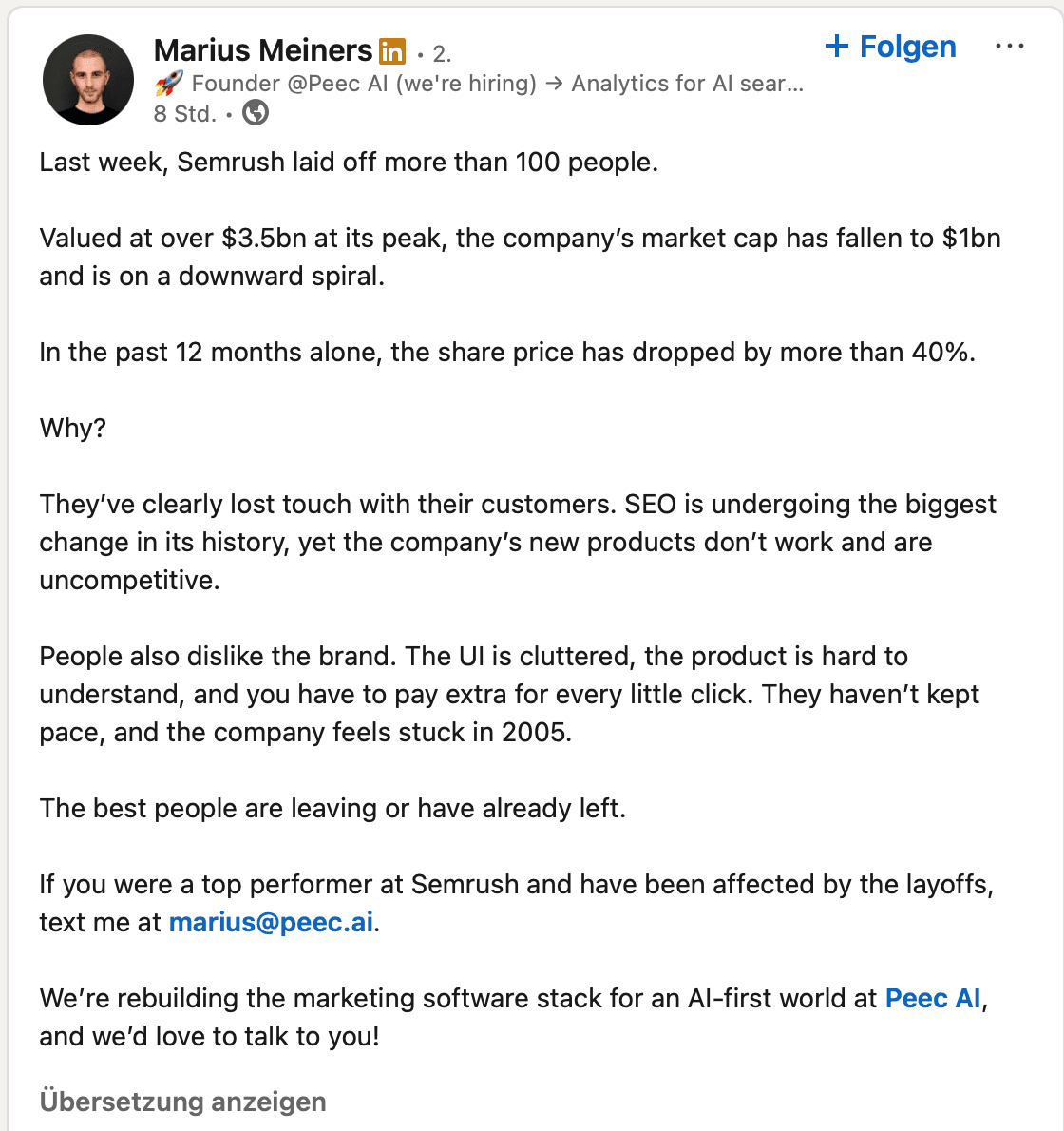Semrush: Alleged layoffs, and is AEO a feature or a company?
Semrush Q2 2025 Earnings: AI and Enterprise Drive Growth, But Lower End Pressures Remain
Some context
According to Marius Meiners (on LinkedIn) Semrush laid off more than 100 people.

It is important to note:
- Marius Meiners is the CEO of Peec AI, a company that does AEO (Answer Engine Optimization, basically SEO for LLMs)
- Semrush is (based on anecodtal evidence) the industry standard for SEO-optimization
- I have not found any addition confirmation of the layoffs
Although there are a ton of SEO-tools, Semrush Marius Meiners has made a few noteworthy comments:
They’ve clearly lost touch with their customers. SEO is undergoing the biggest change in its history, yet the company’s new products don’t work and are uncompetitive. People also dislike the brand. The UI is cluttered, the product is hard to understand, and you have to pay extra for every little click. They haven’t kept pace, and the company feels stuck in 2005. has fallen to $1bn and is on a downward spiral.
I do not share Meiners words:
- I am unsure if people really dislike the brand (based on anecodtal evidence and some comments on Reddit / LinkedIn I don't think that people dislike them)
- I am unsure if the stock is on "a downward spiral" (whatever that means)
- I am unsure if "They’ve clearly lost touch with their customers"
But given that Semrush had their earnings calls a month ago and AI Search is an important topic to me (see below), I wanted to dig a bit into Semrush. So here we go.
Summary of the Call
Most of my analysis is based on Semrush Q2 2025 earnings calls.
The call reflected a confident tone, emphasizing a robust 20% YoY revenue increase to $108.9M and solid operating margins, mainly powered by the surging Enterprise and AI segments. While the company announced successful launches of enterprise AI search products and a major shift of resources away from low-end, high-churn customers, management also tempered near-term expectations: Full-year 2025 revenue guidance was lowered due to ongoing softness among freelancers and unfavorable FX rates, even as the company launched a $150M share buyback to underscore long-term conviction.
That summary was AI generated and it has a few interesting points to unpack. Specifically:
Low-market disruption
From the earnings call:
we continue to experience softness at the lower end of the market. This customer segment includes freelancers and less sophisticated users who have historically had the highest churn rate of our customer cohorts. We also saw a dramatic increase in paid search cost per click in the quarter, which increased our cost to acquire these customers. In the face of the declining unit economics for this lower-value customer segment and given the strong returns we are seeing from our investments in AI search and the enterprise segment, we made a strategic decision to not increase our marketing spend, which would have pursued volume and near-term revenue at the expense of long-term value. Instead, we directed more of our marketing and engineering resources toward our high-growth, high-retention areas, specifically enterprise and AI search, where we are seeing rising customer demand and compelling returns. Now this deliberate resource shift may contribute to near-term revenue headwinds, we are confident it positions us for stronger, more sustainable growth.
Semrush is experiencing something similar to Monday.com. As I have quoted Monday CFO Eliran Glazer, in SaaS Stocks and AI’s Disruption: Monday.com, Salesforce, Gartner & Beyond:
“Demand in general remains very strong. Upmarket, we have record net adds for the $100,000+ customers...We are seeing some softness within the down market due to changes in the Google algorithm, but this is temporary and we are already taking actions proactively to address this.”
Although they are both faced with the same problem, they are reacting differently. On the one side, Monday.com is still pursuing the low-end segment. On the other side, Semrush decided to abandom them (at least to some extend).
Financially, I think, Semrush's move is smart. Strategically, I am unsure. It depends on whether those customers are strategically relevant. I. e. who will serve them? On the one side, I think we'll see an increase of self-made SEO-solutions using N8N, Vibe Coding and Co. (something we are also persuing). On the other side, I'll think that startups like Peec AI will swoop them up. If that happens, I think that Semrush is opening themselves up for classical disruption; ignoring an unsuitable customer segment that will be served by a competitor who might eventually move upmarket.
The thing that's currently unclear is: is its Google's fault that Semrush is losing low-end customers or are they moving to other solutions like Peec AI?
Where is the market heading?
Semrush is currently in a limbo. Although everybody claim's it, nobody knows how much impact AI has on search behavior (see side note below). With that in mind, it is super hard for Semrush to know where to focus on.
Conclusion
So, based on what I have seen, I don't think that Semrush is on a downward spiral. I think that they are currently in a hard position: everybody's proclaiming SEO dead and shouting for AI, but so far there's little evidence for a drastic shift. To me, it is clear that the shift is happening, but how much is still unclear. Thus, it is also unclear how much product innovation is necessary: will AEO require new tools like Peec AI or will AEO be a feature as part of a larger product suite (like in the case of Semrush)?
All of that AEO vs. SEO discussion reminds me a lot of what Jim Collins says in Good to Great:
The good-to-great companies never began their transitions with pioneering technology, for the simple reason that you cannot make good use of technology until you know which technologies are relevant.”
Side Note:
For Researchly, I have spent quite some time dealing with AEO (i. e. optimizing for LLMs). And while it is true that LLMs deliver traffic (we ourselves get customers through ChatGPT), it is still unclear how much traffic they actually take away from traditional search (in my latest newsletter I referenced a few reports - even from Semrush - that don't really paint a clear picture) nor what's the best practice to actually rank. As I have shared on LinkedIn: we did things we weren't supposed to do but still ranked. We did things we were supposed to do and did not rank. So the best advice I have seen regarding these AI-Optimization tools comes from Graphite:
choose the least expensive tool that does the job you need.
How We Did This
All insights powered by our earnings call analysis tool.
Want to run your own analysis? Try it here for free.
